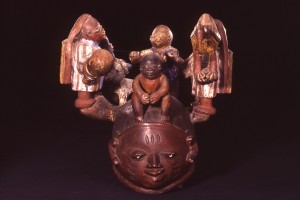Lesson Plan
Days 1-3: Read Aloud
Direct Instruction
Read a variety of African folktales listed above.
Short video clips can also be found by searching on You Tube, like this one done by Sesame Street.
Have the students become familiar with a number of different African folktales.
Day 4: Interactive Writing
Direct Instruction
Discuss the various folktales that the class has been reading:
- Ask what they all have in common.
- Discuss characters and setting.
As a class, write a new folktale. Divide large chart paper into 4-6 sections. Point to each and decide as a class what is going to be written. Construct the story, sharing the pen with the students. Reread, revise, and proofread.
Guided Practice/Application
Have students return to their seats and draw a favorite character, or part of the setting, to then attach to the chart paper.
Day 5: Brainstorm with artwork
Direct Instruction
Display reproduction photos of Gelede Helmet Mask, 20th century, Yoruba Peoples.
Discuss artwork using open-ended questions:
- What’s going on in this picture?
- What do you see that makes you say that?
- What more can we find?
Then ask the students to consider the African folktales that the class has read and discussed. How could this object be used in a folktale?
- Is it something a character finds?
- Is it something a character makes?
- Could it come to life?
- Was it lost and found?
- Does it have special powers? Brainstorm as a class.
Then explain that students will work with a partner to write their own folktale. This object will need to be a part of the story. Students may make some imaginary changes to object to make it fit into the story. For example, each of the figures could be doing something different or holding different objects.
Guided Practice /Application
Students work with partners on a graphic organizer that is divided into 6 sections to organize their folktale. They could also go to the computer lab and do their brainstorming using a program like Kidspiration.
This work may continue for several days.
Final product will be published using a word processor and then shared with the class.
Day 6: Optional Extension
Have students work with partners to create their own helmet similar to Gelede Helmet Mask. This could be the object they envisioned as part of their folktale.
Possible materials: use kid’s construction hats, old toddler bike helmets, fireman hats, Halloween costume masks. They can collect old action figures or Happy Meal figures that adults will help to attach with hot glue. They may be able to attach some using chenille sticks.
Students could then share these objects with the class and retell their stories using them as props.

